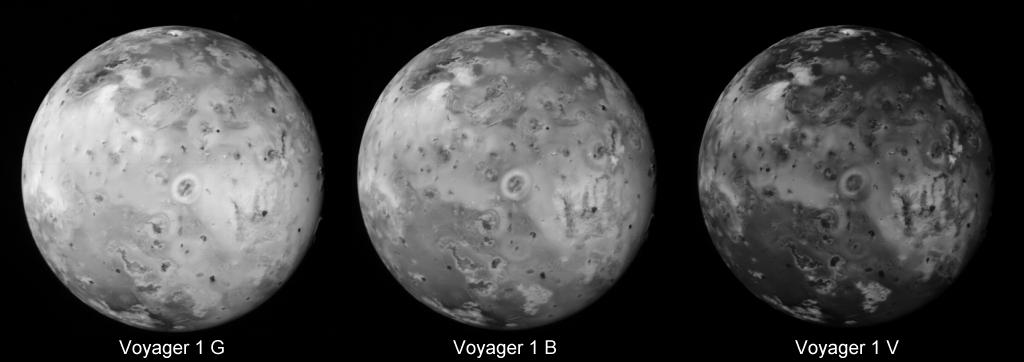
Io's color
The color renderings of Io near the bottom of this page were created using a new map of Io I'm finishing. They show attempts to get Io's color right. This particular map is based on the best Voyager 1 and Galileo spacecraft images. The color is taken entirely from Galileo images since Galileo has a far better camera for obtaining true color images than the Voyager spacecraft.A problem when creating true color images or renderings of Io is that no spacecraft carrying red, green and blue filters for true-color imaging has flown by Io at close range. The Voyager spacecraft that flew through the Jovian system in 1979 carried orange, green and blue filters. The Galileo spacecraft that entered Jupiter orbit in 1995 carried red, green and violet filters. Since Galileo's camera was much better than Voyager's and a red filter is more important than a blue filter for true color imaging in Io's case it is necessary to create synthetic blue images to use instead of Galileo's violet images if true color is desired.
I created this synthetic blue color by combining green and violet filtered Galileo images. Which combination of green and violet to use was determined using measurements of green, blue and violet images obtained by the Voyager 1 spacecraft (below).

As mentioned above, unlike Galileo the Voyager spacecraft camera had a blue filter. The images above show that a Voyager blue filtered image lies somewhere between the green and violet images in its appearance - if anything it's looks more similar to the green image. Measuring various terrain types in all three images reveals that roughly B=0.6xG + 0.4xV if a linear combination of G and V is used. Exactly which combination to use isn't absolutely clear - it depends on which images are used to determine this because of Io's hemispherical brightness and color asymmetry (the Jupiter-facing hemisphere is darker and redder). From my results B=0.61xG+0.39xV but anything between 0.55 to 0.65xG could be correct. Even better results are obtained if blue images are synthesized using a more complex non-linear formula. The montage below shows the results from several different combinations of G/V to create B.

The rendering at upper left has colors that are similar to the colors in most of the 'true color' images from the Galileo spacecraft that have been released. These use images taken through the red, green and violet filters as red, green and blue respectively. As indicated above, the problem with this is that images taken in violet light are darker and much more contrasty than images at longer wavelengths, including blue. The rendering at upper right has what may be the most realistic color; it was created using a synthetic blue image created from a non-linear combination of the green and violet images. The bottom four images show the results of using various linear combinations of G and V as B. The one at lower left uses the G/V combination that best fits Voyager 1 blue images in a least squares sense and looks very similar to the image at upper right (the RG, best B image).
Is should be pointed out all of these images may be considerably inaccurate compared to Io's true color. Io has a weird spectrum where the brightness of individual features varies greatly with wavelength. In fact I cannot rule out that the image at upper left (the RGV image) is in fact the most accurate one but I think it is unlikely. The image at upper right is in my opinion more likely than the other images to be accurate.